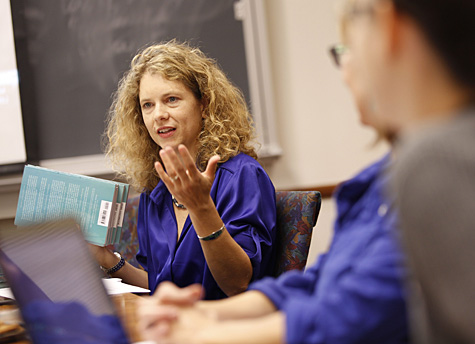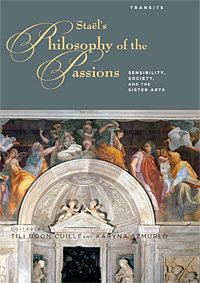
Do things ever get contentious?
Rarely! The tenor is rigorous but also collegial and constructive — the ideal combination, really. Presenters are able to vet questions that, coming from an academic journal, might be formulated in much more contentious terms. That’s when egos get destroyed, and when the piece risks ending up on the cutting room floor.
Here, you’re face-to-face, which encourages people to be generous scholars.
You’ve led the group since 2002. Have you gone through the wringer yourself?
Yes, absolutely. When I first arrived on campus, in 2000, I presented the first chapter of my book, Narrative Interludes: Musical Tableaux in Eighteenth-Century French Texts. Salon members told me that I needed an introduction defining the conception of the musical tableau.
So let’s talk about your scholarship. What is a musical tableau?
Basically, this is a performance within a text. It has a lot of affinities with a play-within-a-play, but it’s frequently constituted as one character watching or listening to a performance by another. I was specifically interested in looking at what is unleashed in such scenes — what’s happening visually, what’s happening musically, what’s happening in terms of textual form. How is the author experimenting with non-linguistic forms of expression, which were thought to be more powerful and authentic than language?
But this is more than just a formal device.
That’s right. Narrative Interludes is divided into two parts. In the first, I look at a group of male authors who participated in the 18th-century “Opera Quarrels,” which were sparked, in part, by Rousseau’s statements about the limitations of the French language. I then look at some of the women authors who were inspired by Rousseau’s texts but felt excluded by his positions on gender. I look at how they construct musical tableaux that specifically counter Rousseau’s critique.

What are you working on these days?
I recently co-edited a volume on Germaine de Staël with Karyna Szmurlo, professor of French at Clemson University, entitled Staël’s Philosophy of the Passions: Sensibility, Society, and the Sister Arts. It will be released later this year as part of the Transits series from Bucknell University Press.
My current manuscript, Divining Nature: French Ventures in Fiction, Imagery, and Stagecraft, juxtaposes the revolution in the natural sciences with works by composers, artists and authors, rather than treating them as separate domains. The first chapter, for example, looks at the Comte de Buffon, who set out to write an exhaustive description of nature, and the composer Jean-Philippe Rameau, who sought to stage nature in his operas. The affinities in their projects are legion.
It’s interesting how porous the lines between disciplines could be.
Absolutely. I justify my interdisciplinary approach by noting that I’m working on a pre-disciplinary time period. It precedes the 19th-century breakdown into fields. Eighteenth-century philosophers were also scientists and authors. The notion of experimentation carried across from natural history to the arts. For us to talk about these things separately is artificial and anachronistic.
One last question. You have two children — Elena, 8, and Rémi, 4. What kinds of stories do you read to them?
It’s funny, a lot of the texts I work with are metatexts, or texts that recognize their own status as texts. And one of the first books I gave Elena was The Phantom Tollbooth, which was a favorite from my own youth. It’s set in a world in which things that happen linguistically are literalized.
If you jump to conclusions, you actually jump.